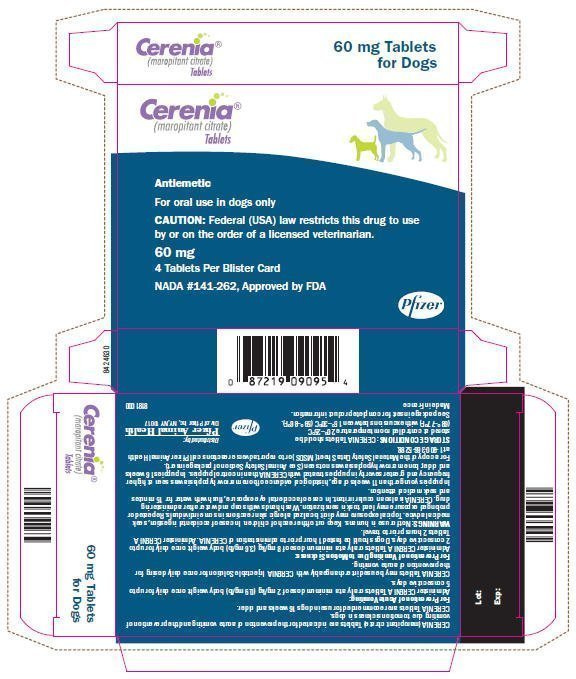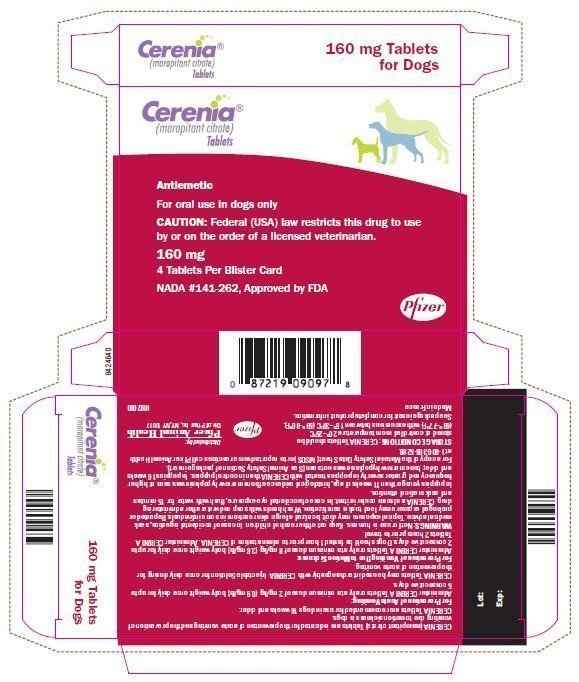Cerenia Prescribing Information
Package insert / product label
Generic name: maropitant citrate
Dosage form: FOR ANIMAL USE ONLY
On This Page
Cerenia Description
Maropitant is a neurokinin (NK1) receptor antagonist that blocks the pharmacological action of substance P in the central nervous system (CNS). Maropitant is the non-proprietary designation for a substituted quinuclidine. The empirical formula is C32H40N2O C6H8O7 H2O and the molecular weight 678.81. The chemical name is (2S,3S)-2-benzhydryl-N-(5-tert-butyl-2-methoxybenzyl) quinuclidin-3-amine citrate monohydrate. Each peach-colored oval tablet is scored and contains 16, 24, 60 or 160 mg of maropitant as maropitant citrate per tablet.
The chemical structure of maropitant citrate is:
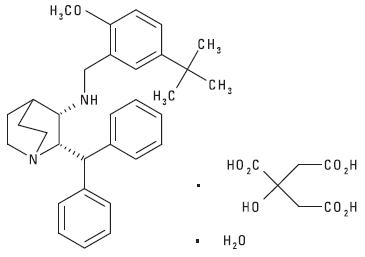
INDICATIONS
CERENIA (maropitant citrate) Tablets are indicated for the prevention of acute vomiting and the prevention of vomiting due to motion sickness in dogs.
Cerenia Dosage and Administration
CERENIA Tablets are recommended for use in dogs 16 weeks and older.
For Prevention of Acute Vomiting
Administer CERENIA Tablets orally at a minimum dose of 2 mg/kg (0.9 mg/lb) body weight once daily for up to 5 consecutive days.
| Minimum of 2 mg/kg BW Dosing | ||||
|---|---|---|---|---|
| Dog body weight | Number of Tablets | |||
| Pounds | Kilograms | 16 mg | 24 mg | 60 mg |
| 2.2 – 8.8 | 1.0 – 4.0 | ½ | ||
| 8.9 – 17.6 | 4.1 – 8.0 | 1 | ||
| 17.7 – 26.4 | 8.1 – 12.0 | 1 | ||
| 26.5 – 52.8 | 12.1 – 24.0 | 2 | ||
| 52.9 – 66.0 | 24.1 – 30.0 | 1 | ||
| 66.1 – 132.0 | 30.1 – 60.0 | 2 | ||
CERENIA Tablets may be used interchangeably with CERENIA Injectable Solution for once daily dosing for the prevention of acute vomiting.
For Prevention of Vomiting Due to Motion Sickness
Administer CERENIA Tablets orally at a minimum dose of 8 mg/kg (3.6 mg/lb) body weight once daily for up to 2 consecutive days. Dogs should be fasted 1 hour prior to administration of CERENIA Tablets. Administer CERENIA Tablets 2 hours prior to travel.
| Minimum of 8 mg/kg BW Dosing | |||||
|---|---|---|---|---|---|
| Dog body weight | Number of Tablets | ||||
| Pounds | Kilograms | 16 mg | 24 mg | 60 mg | 160 mg |
| 2.2 | 1 | ½ | |||
| 2.3 – 3.3 | 1.1 – 1.5 | ½ | |||
| 3.4 – 4.4 | 1.6 – 2.0 | 1 | |||
| 4.5 – 6.6 | 2.1 – 3.0 | 1 | |||
| 6.7 – 8.8 | 3.1 – 4.0 | 2 | |||
| 8.9 – 13.2 | 4.1 – 6.0 | 2 | |||
| 13.3 – 16.5 | 6.1 – 7.5 | 1 | |||
| 16.6 – 22.0 | 7.6 – 10.0 | ½ | |||
| 22.1 – 33.0 | 10.1 – 15.0 | 2 | |||
| 33.1 – 44.0 | 15.1 – 20.0 | 1 | |||
| 44.1 – 66.0 | 20.1 – 30.0 | 1½ | |||
| 66.1 – 88.0 | 30.1 – 40.0 | 2 | |||
| 88.1 – 132.0 | 40.1 – 60.0 | 3 | |||
WARNINGS
Not for use in humans. Keep out of the reach of children. In case of accidental ingestion, seek medical advice. Topical exposure may elicit localized allergic skin reactions in some individuals. Repeated or prolonged exposure may lead to skin sensitization. Wash hands with soap and water after administering drug. CERENIA is also an ocular irritant. In case of accidental eye exposure, flush with water for 15 minutes and seek medical attention.
In puppies younger than 11 weeks of age, histological evidence of bone marrow hypoplasia was seen at higher frequency and greater severity in puppies treated with CERENIA than in control puppies. In puppies 16 weeks and older, bone marrow hypoplasia was not seen (See Animal Safety Section).
Precautions
The safe use of CERENIA Tablets has not been evaluated in dogs used for breeding, pregnant or lactating bitches, dogs with gastrointestinal obstruction, or dogs that have ingested toxins. Use with caution in dogs with hepatic dysfunction. Use with caution with other medications that are highly protein bound. The concomitant use of CERENIA with other protein bound drugs has not been studied in dogs. Commonly used protein bound drugs include NSAIDs, cardiac, anticonvulsant and behavioral medications. The influence of concomitant drugs that may inhibit metabolism of CERENIA has not been evaluated. Drug compatibility should be monitored in patients requiring adjunctive therapy.
Adverse Reactions/Side Effects
Prevention of Acute Vomiting (minimum of 2 mg/kg)
The following adverse reactions were reported during the course of a US field study for the prevention of acute vomiting in dogs treated with CERENIA Tablets at a minimum of 2 mg/kg orally and/or Injectable Solution at 1.0 mg/kg subcutaneously once daily for up to 5 consecutive days:
| Adverse Reaction | Placebo (n=69) | CERENIA (n=206) | ||
|---|---|---|---|---|
| # dogs | % occurrence | # dogs | % occurrence | |
| Death during study | 4 | 5.8 | 10 | 4.9 |
| Euthanized during study | 0 | 0 | 2 | 1.0 |
| Diarrhea | 6 | 8.7 | 8 | 3.9 |
| Hematochezia/bloody stool | 5 | 7.2 | 4 | 1.9 |
| Anorexia | 2 | 2.9 | 3 | 1.5 |
| Otitis/Otorrhea | 0 | 0 | 3 | 1.5 |
| Endotoxic Shock | 1 | 1.4 | 2 | 1.0 |
| Hematuria | 0 | 0 | 2 | 1.0 |
| Excoriation | 0 | 0 | 2 | 1.0 |
Other clinical signs were reported but were <0.5% of dogs.
Prevention of Vomiting Due to Motion Sickness (minimum of 8 mg/kg)
The following adverse reactions were reported during US studies for the prevention of vomiting due to motion sickness in dogs treated with CERENIA Tablets at a minimum of 8 mg/kg orally one time. Dogs may have experienced more than one of the observed adverse reactions.
| Adverse Reaction | Placebo (n=195 ) | CERENIA (n=208 ) | ||
|---|---|---|---|---|
| # dogs | % occurrence | # dogs | % occurrence | |
|
||||
| Hypersalivation | 19 | 9.7 | 26 | 12.5 |
| Vomiting* | 0 | 0 | 11 | 5.3 |
| Muscle Tremors | 1 | 0.5 | 2 | 1.0 |
| Sedation/Depression | 3 | 1.5 | 2 | 1.0 |
| Retching | 3 | 1.5 | 1 | 0.5 |
| Flatulence | 0 | 0 | 1 | 0.5 |
The following adverse reactions were reported during a European field study for the prevention of vomiting due to motion sickness in dogs treated with CERENIA Tablets at a minimum of 8 mg/kg orally once daily for 2 consecutive days. Dogs may have experienced more than one of the observed adverse reactions.
| Adverse Reaction | Placebo (n=106 ) | CERENIA (n=107 ) | ||
|---|---|---|---|---|
| # dogs | % occurrence | # dogs | % occurrence | |
| Vomiting | 4 | 4 | 10 | 9 |
| Drowsiness/Lethargy/Apathy | 1 | 1 | 8 | 8 |
| Hypersalivation | 2 | 2 | 5 | 5 |
| Anxiety | 0 | 0 | 2 | 2 |
| Trembling/Tremors | 0 | 0 | 2 | 2 |
| Inappetence | 0 | 0 | 2 | 2 |
| Mucus in stool | 0 | 0 | 1 | 1 |
For a copy of the Material Safety Data Sheet (MSDS) or to report adverse reactions call Pfizer Animal Health at 1-800-366-5288.
Cerenia - Clinical Pharmacology
Pharmacokinetics
The pharmacokinetic characterization associated with maropitant after oral (PO) or subcutaneous (SC) administration in adult Beagle dogs is provided in the table below.
| SC at 1 mg/kg (n=6) | PO at 2 mg/kg (n=8) | PO at 8 mg/kg (n=8) | |
|---|---|---|---|
| AUC0-inf (hr*ng/mL) | 860±137 | 561±322 | 7840±5600 |
| Cmax (ng/mL) | 92±34 | 81±32 | 776±604 |
| T½ (hr) | 8.84 (6.07-17.7) | 4.03 (2.48-7.09) | 5.46 (3.39-7.65) |
| Tmax (hr) | 0.75±1.11 | 1.9±0.5 | 1.7±0.7 |
The absolute bioavailability of maropitant was much higher following SC injection (91% at 1 mg/kg) than after PO administration (24% at 2 mg/kg). Oral bioavailability may be underestimated due to the presence of nonlinear kinetics and the resulting longer T½ seen after intravenous (IV) administration. Although hepatic first-pass metabolism contributed to the relatively low bioavailability after an oral dose, prandial status does not significantly affect the extent of oral bioavailability. Greater than dose-proportional drug exposure can be expected with an increase in dose (1-16 mg/kg PO). Systemic clearance of maropitant following IV administration was 970, 995, and 533 mL/hr/kg at doses of 1, 2 and 8 mg/kg, respectively. An accumulation ratio of 1.5 was observed following once-daily use of maropitant for five consecutive days at 1 mg/kg (SC) or 2 mg/kg (PO). Urinary recovery of maropitant and its major metabolite was minimal (<1% each). The hepatic metabolism of maropitant involves two cytochrome P-450 isoenzymes: CYP2D15 and CYP3A12. Based on in vitro enzyme kinetics data, it is believed that the non-linear kinetics may be partially associated with saturation of the low capacity enzyme (CYP2D15). However as doses increase (20-50 mg/kg PO), dose proportionality is re-established. Based upon in vitro enzyme kinetics, involvement of a high capacity enzyme (CYP3A12) may contribute to this return to dose linearity. Plasma protein binding of maropitant was high (99.5%).
Pharmacodynamics
Vomiting is a complex process coordinated centrally by the emetic center which consists of several brainstem nuclei (area postrema, nucleus tractus solitarius, dorsal motor nucleus of the vagus) that receive and integrate sensory stimuli from central and peripheral sources and chemical stimuli from the circulation and the cerebro-spinal fluid. Maropitant is a neurokinin 1 (NK1) receptor antagonist which acts by inhibiting the binding of substance P, a neuropeptide of the tachykinin family. Substance P is found in significant concentrations in the nuclei comprising the emetic center and is considered the key neurotransmitter involved in emesis.1 By inhibiting the binding of substance P within the emetic center, maropitant provides broad-spectrum effectiveness against neural (central) and humoral (peripheral) causes of vomiting. In vivo model studies in dogs have shown that maropitant has antiemetic effectiveness against both central and peripheral emetogens including apomorphine, and syrup of ipecac.
- 1
- Diemunsch P, Grelot L. Potential of substance P antagonists as antiemetics. [Review] [60 refs]. Drugs. 2000;60:533-46.
EFFECTIVENESS
Prevention of Acute Vomiting
In laboratory model studies, CERENIA Tablets dosed at a minimum of 2 mg/kg BW reduced the number of emetic events associated with established neural (central) and humoral (peripheral) stimuli. Following administration of apomorphine (central emetic stimuli), vomiting was observed in 33% (4 of 12) of Beagle dogs treated with CERENIA Tablets and 100% (12 of 12) of Beagle dogs treated with placebo tablets. Following administration of syrup of ipecac (peripheral emetic stimuli) vomiting was observed in 33% (4 of 12) of Beagle dogs treated with CERENIA Tablets and in 83% (10 of 12) of Beagle dogs treated with placebo tablets.
In a study of 275 canine patients presented to veterinary hospitals with a history of acute vomiting, dogs were initially administered CERENIA Injectable Solution or placebo on Day 0. Following the initial dose, dogs allocated to the CERENIA group were treated with either CERENIA Tablets at a minimum of 2 mg/kg orally or Injectable Solution at 1 mg/kg subcutaneously once daily at the discretion of the clinician. Dogs allocated to the placebo group were treated using either an injectable placebo solution or placebo tablets once daily at the discretion of the clinician. Of the 199 dogs included in the analysis for effectiveness, 27 of 54 dogs (50%) in the placebo group displayed vomiting at some time during the study and 31 of 145 dogs (21.4%) in the treated group displayed vomiting during the study period.
| Days | Treatment | Route | # dogs | # vomited | % vomited |
|---|---|---|---|---|---|
|
|||||
| Day 0 | Placebo (54) | SC | 54 | 15 | 28% |
| CERENIA (145) | SC | 145 (143*) | 14 | 10% | |
| Day 1 | Placebo (45) | PO | 22 | 3 | 14% |
| SC | 23 | 16 | 70% | ||
| CERENIA (108) | PO | 67 | 2 | 3% | |
| SC | 41 | 16 | 39% | ||
| Day 2 | Placebo (16) | PO | 7 | 2 | 29% |
| SC | 9 | 6 | 67% | ||
| CERENIA (37) | PO | 24 | 0 | 0% | |
| SC | 13 | 8 | 62% | ||
| Day 3 | Placebo (6) | PO | 2 | 0 | 0% |
| SC | 4 | 1 | 25% | ||
| CERENIA (21) | PO | 14 | 0 | 0% | |
| SC | 7 | 5 | 71% | ||
| Day 4 | Placebo (2) | PO | 1 | 0 | 0% |
| SC | 1 | 1 | 100% | ||
| CERENIA (7) | PO | 5 | 0 | 0% | |
| SC | 2 | 1 | 50% | ||
| Day 5 | CERENIA (1) | SC | 1 | 0 | 0% |
Prevention of Vomiting due to Motion Sickness
In a study of canine veterinary patients taken on a one-hour car journey and treated with either CERENIA Tablets at a minimum dose of 8 mg/kg BW or placebo tablets 2 hours prior to the journey, 67 of 122 (55%) of dogs vomited during the journey when treated with placebo while 8 of 122 (7%) vomited during the journey after treatment with CERENIA Tablets. The probability that a dog in this study, prone to motion sickness would NOT vomit during a journey if treated with CERENIA Tablets was 93%, while the probability was 48% if treated with placebo.
ANIMAL SAFETY
Laboratory and field studies have demonstrated that CERENIA Tablets are well tolerated in dogs after oral administration.
Target Animal Safety Study for Acute Vomiting
Fifty six Beagle dogs (28 males and 28 females) approximately 16 weeks of age were administered CERENIA Tablets orally once daily for 15 days at 0, 2, 6, and 10 mg/kg. There were 8 dogs (4 males and 4 females) in the 2 mg/kg group and 16 dogs (8 males and 8 females) in all other groups. CERENIA Tablets caused decreases in food consumption and body weight that were not dose-dependent and did not persist after cessation of treatment.
Beagle dogs approximately 8 weeks of age were administered CERENIA Tablets orally once daily for 15 days at 0, 2, 6, and 10 mg/kg using a protocol similar to the previous study. A dose dependent increase in severity of bone marrow hypoplasia was observed histologically. Interpretation of these study results is complicated by the health status of study animals. Dogs used in the study were weaned early, minimally acclimated to the test facility, many of the dogs in the study tested positive for coccidia and some tested positive for canine parvovirus.
Target Animal Safety Study for Motion Sickness
Forty Beagle dogs (20 males and 20 females) between 16 – 18 weeks of age were administered CERENIA Tablets orally once daily for 6 days at 0, 8 and 24 mg/kg. There were 16 dogs (8 males and 8 females) in the 0 and 24 mg/kg groups and 8 dogs (4 males and 4 females) in the 8 mg/kg group. At 24 mg/kg, CERENIA Tablets caused decreases in food consumption, with decreases in body weight, liver and testis weight; and an increase in RBC count indicating hemoconcentration, but the effects on feed consumption, body weight, and RBCs did not persist in the post-treatment recovery period (beyond Day 5).
Beagle dogs approximately 8 weeks of age were administered CERENIA Tablets orally once daily for 6 days at 0, 8, and 24 mg/kg using a protocol similar to the previous study. One dog in the 24 mg/kg/day group died of unknown causes on study day 2 and a dose dependent increase in occurrence and severity of bone marrow hypoplasia and lymphoid depletion was observed histologically. Interpretation of these study results is complicated by the health status of study animals. Dogs used in the study were weaned early, minimally acclimated to the test facility, and many of the dogs in the study tested positive for coccidia. Additionally, some dogs in the study tested positive for canine parvovirus, however, clinical parvoviral disease was not definitively diagnosed.
Tolerance Study
Twenty four Beagle dogs (14 males and 10 females) between 11 and 25 weeks of age were administered CERENIA Tablets in 2 phases with 8 dogs per group. In the first phase the dogs were administered 0, 20 or 30 mg/kg orally once daily for 7 days and in the second phase 0, 40, or 50 mg/kg once daily for 7 days. CERENIA Tablets administered at 20 and 30 mg/kg caused occasional vomiting. CERENIA Tablets administered at 40 mg/kg and 50 mg/kg caused clinically relevant signs of weight loss, vomiting, soft stools, weakness, lethargy, salivation and hypokalemia. Additionally, leukopenia characterized by a neutropenia and a trend toward decreasing plasma phosphorus values was seen. Decreased heart rate and prolonged corrected QT intervals were seen in all treatment groups in a dose dependent manner.
In US field studies in veterinary patients, CERENIA Tablets and Injectable Solution were well tolerated in dogs presenting with various conditions including parvovirus, gastroenteritis, and renal disease. There were no notable differences in mean laboratory values between CERENIA-treated and placebo-treated patients.
CERENIA Tablets were used safely in dogs receiving other frequently used veterinary products such as fluid and electrolyte replacement solutions, antimicrobial agents, vaccines, antacids, and antiparasitic agents.
Storage and Handling
CERENIA Tablets should be stored at controlled room temperature 20°–25°C (68°–77°F) with excursions between 15°–30°C (59°–86°F).
How is Cerenia supplied
CERENIA peach-colored tablets are scored with a break line, and contain 16, 24, 60 or 160 mg of maropitant as maropitant citrate per tablet. Each tablet is marked with "MPT" and the tablet strength on one side and the Pfizer logo on the other. Each tablet size is packaged in blister packs containing 4 tablets per perforated sheet.
PRINCIPAL DISPLAY PANEL - 16 mg Tablets Carton
Cerenia®
(maropitant citrate)
Tablets
Antiemetic
For oral use in dogs only
CAUTION: Federal (USA) law restricts this drug to use
by or on the order of a licensed veterinarian.
16 mg
4 Tablets Per Blister Card
NADA #141-262, Approved by FDA
Pfizer
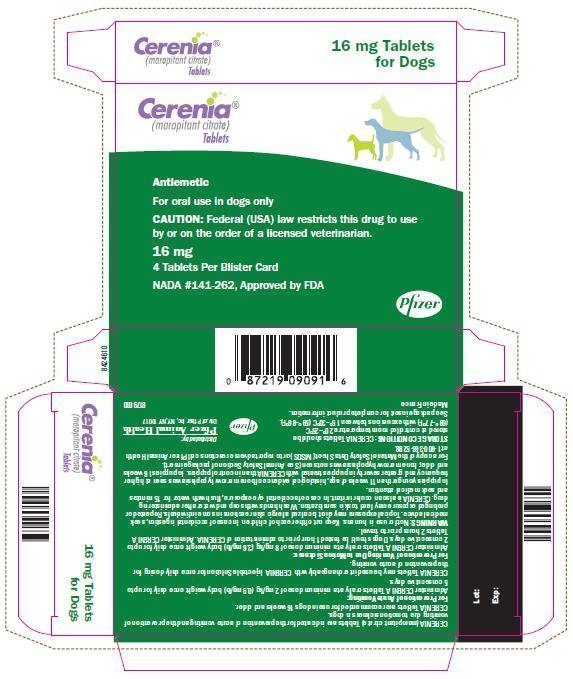
PRINCIPAL DISPLAY PANEL - 24 mg Tablets Carton
Cerenia®
(maropitant citrate)
Tablets
Antiemetic
For oral use in dogs only
CAUTION: Federal (USA) law restricts this drug to use
by or on the order of a licensed veterinarian.
24 mg
4 Tablets Per Blister Card
NADA #141-262, Approved by FDA
Pfizer
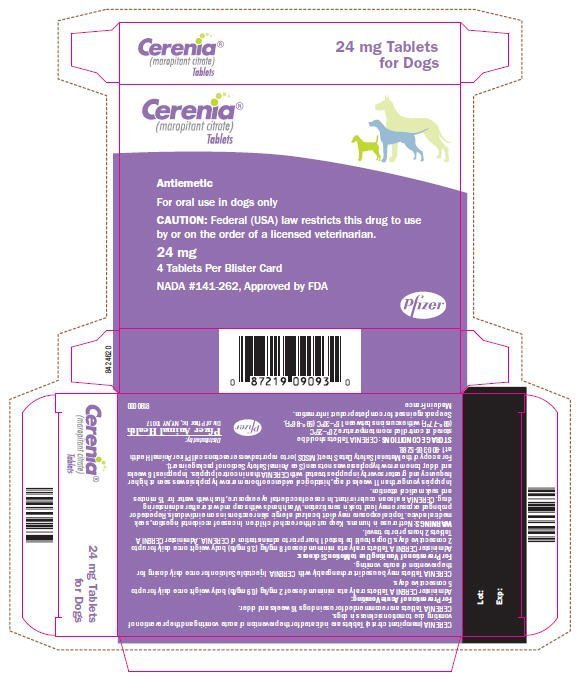
| CERENIA
maropitant citrate tablet |
||||||||||||||||||
|
||||||||||||||||||
|
||||||||||||||||||
|
||||||||||||||||||
|
||||||||||||||||||
|
||||||||||||||||||
| CERENIA
maropitant citrate tablet |
||||||||||||||||||
|
||||||||||||||||||
|
||||||||||||||||||
|
||||||||||||||||||
|
||||||||||||||||||
|
||||||||||||||||||
| CERENIA
maropitant citrate tablet |
||||||||||||||||||
|
||||||||||||||||||
|
||||||||||||||||||
|
||||||||||||||||||
|
||||||||||||||||||
|
||||||||||||||||||
| CERENIA
maropitant citrate tablet |
||||||||||||||||||
|
||||||||||||||||||
|
||||||||||||||||||
|
||||||||||||||||||
|
||||||||||||||||||
|
||||||||||||||||||
| Labeler - Pfizer Animal Health (039055157) |
| Establishment | |||
| Name | Address | ID/FEI | Business Operations |
|---|---|---|---|
| Pfizer PGM | 397047957 | ANALYSIS, MANUFACTURE | |


